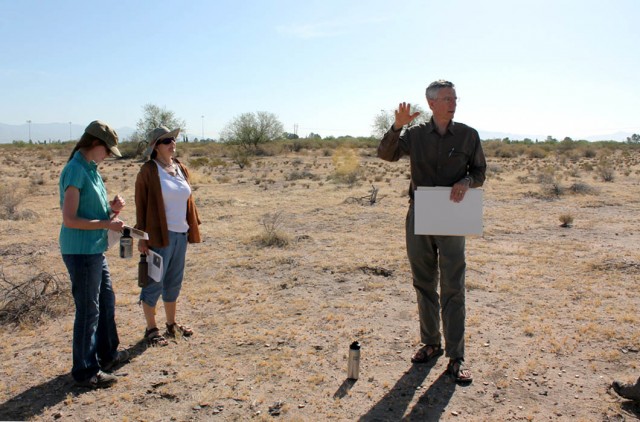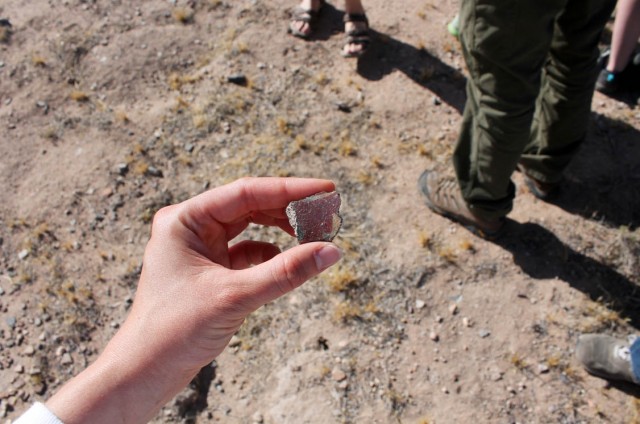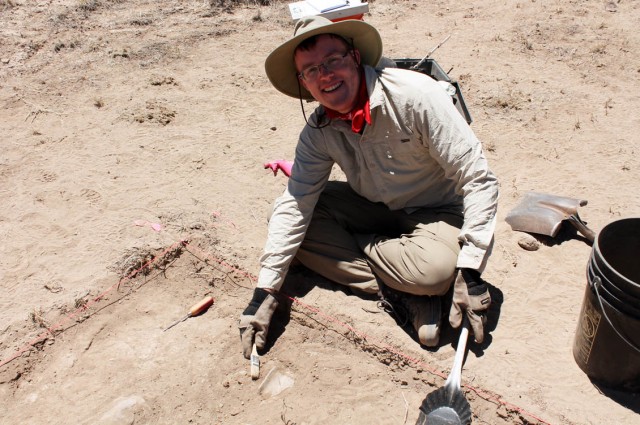- Home
- >
- Preservation Archaeology Blog
- >
- Archaeological Eyes
By Ely Rareshide, field school student from Rice University
Before we put trowel to dirt at the Dinwiddie site, we first visited the Valencia site at Pima Community College, Desert Vista Campus, to train our “archaeological eyes.” Bill Doelle led us through the site and explained how to interpret the landscape and find surface artifacts. Such noninvasive techniques are an important part of Preservation Archaeology.

For example, middens—ancient trash heaps—are full of organic materials that decompose into rich soil. These ancient compost piles are fertile ground for modern plants, which tend to cluster in middens, rather than the surrounding land. At the Dinwiddie site, we want to focus our test excavations in middens, in order to leave architectural remains undisturbed.
In contrast to middens, plazas generally have hard-packed soil from people walking on them. Consequently, vegetation in ancient plazas is usually sparser than in other areas. Bill also pointed out an ancient ballcourt, distinguished by its parallel berms (ancient bleachers?) surrounding a depression in the land where players engaged in the game.
As we walked across the Valencia site, Bill taught us to turn on our archaeological eyes, sweeping our gazes across the ground in search of artifacts on the surface of the land. Some areas were full of pottery sherds and lithics, flaked stone tools and the waste flakes resulting from the tools’ manufacture. The density of artifacts was another clue we used to identify where people were living centuries ago.

When we started work at the Dinwiddie site, we first walked over the site looking for changes in vegetation, terrain, soil color, and artifact density. After overcoming an ornery rattlesnake that threatened us at a prime potential midden, we laid out 2-meter by 1-meter test excavation units where we hoped to dig into ancient trash.
In Unit 100, Jay, Thatcher, and I recovered a large rim sherd of pottery. Danny Welch, our Teaching Assistant (TA), taught us how to uncover it carefully, by moving from “known to unknown.” In this technique, we learned to work from where part of the sherd was visible to the surrounding mystery soil. Starting at the spot where we (actually, Danny!) first noticed into the sherd, we brushed soil away in order to determine the size of the sherd before mapping, lifting, and bagging it.

3 thoughts on “Archaeological Eyes”
Comments are closed.
Explore the News
-
Join Today
Keep up with the latest discoveries in southwestern archaeology. Join today, and receive Archaeology Southwest Magazine, among other member benefits.
Very cool! : )
what’s a lithic? What does a soil color tell you?
Love reading about your experiences, Ely. Seeing the pix helps me place you physically. Thanks for posting.